ALLIGATOR
BEHAVIOR page 6e: ON LAND; WALKING AND BASKING page 5 page 1 2
3 4 6
7 8
9 10
This
page was born 10/20/2006. Rickubis designed it. (such as
it
is.) Last update: 7/14/2015
Images
and contents on this page copyright ©2002-2015 Richard M.
Dashnau
Alligators
although amphibious (not AMPHIBIANS) are in the water most of
the time
when they are active. Therefore it is worthy of note when they are
on land,
especially when they are doing more than just absorbing solar
energy. Here is yet another page of terrestrial alligator
antics.
April
14, 2005
I've been somewhat disappointed this spring. I haven't seen much
alligator
activity so far, and I haven't been near any alligators bellowing
so far.
For the last few
years, I'd had a number of encounters before this time
of year (usually I'd hear bellowing weeks before Daylight Saving
Time).
I've still seen a number of interesting things, but
have been pretty busy
with other projects. Last Tuesday, April 12th, I had time to visit
the
park again. Still no bellowing, but I saw some alligator activity.
I've
got a couple
sequences that seem to show the females approaching the much
larger male alligators. I saw 3 different cases of this--two of
which involved
two of the smaller alligators
(about 6-7 feet long) approaching the same
large (about 10 feet long) male within 10 minutes of one another.
I'll
note more of this later.
The
image below (YAWNING IN THE SUN) shows two alligators showing the
thermal
gape. This is behavior that becomes apparent usually after an
alligator
has been in the
sun for a period of time--at least that's what I've observed.
The
larger alligator had just come ashore, though, about 15 minutes
before
he started gaping. There was no other
movement or sound accompanying the
gape.
---------------------------------------------------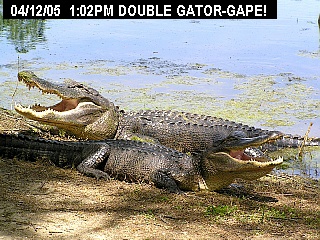
About
15 minutes before *this*, I was passing the 7th Elm Lake pier when
I noticed
a large alligator (this large one) swimming straight for a spot
under a
Willow tree. I thought
it intended to come ashore, and possibly cross.
I walked
to a decent vantage point, but the alligator stopped about 4 feet
from
the bank. It stopped moving, and I watched for a
few minutes. It backed
away from the bank slightly (I was at least 20 feet away.) so I
moved towards
Pilant Lake, where I'd noticed some Garfish at the surface. I had
my camera
down by my waist when the large alligator suddenly raised his
snout--indicating
perhaps a bellow. I just had time to bring my viewfinder to my
face when
he did a single
grunt/headslap. Then he backed away from the bank,
and swam straight to the bank where a smaller alligator (the one
in the
picture) was already basking. Then, without
much pause, he climbed up near
the other alligator, basked a while, and then started gaping.
So,
it was an excellent day after all. The weather was great, I
watched alligators
in a quiet park; a Broadbanded Water Snake crossed the
trail...almost going
between my feet!
June
4, 2006--The park has been going
through a
long dry spell. As water levels have been receding, the alligator
have
been moving around more. I watched this large alligator
moving down the
shallow remnants of Pilant Slough, near the Spillway Bridge.
(the
large
images below are animated gifs. refresh the page if they
aren't moving.)
--------------------------------------------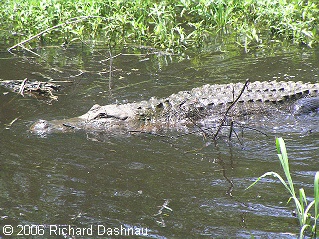 -
-
MOVING ALONG
Without
any previous indication, it assumed the bellowing position,
and issued
a single short bellow.
--------------------------------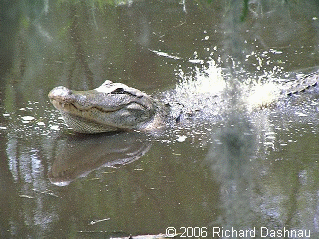
THE BELLOW
Then
it turned, moved to the bank, and walked up to the Spillway Trail
(near
where I was standing). It stopped at the edge of the trail to
rest.
--------------------------------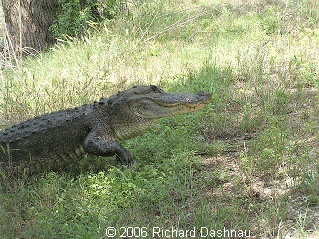 -
-
WALKING UP TO THE TRAIL
After
about 5 minutes, it gaped.-----------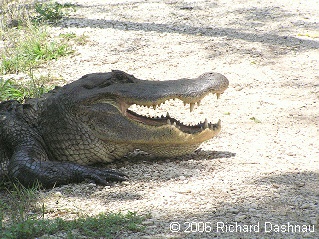
I don't
think this was a heat-regulation gape. Sometimes an alligator will
gape
like this (without hissing or any other signal) before moving over
land,
and I believe gape is used
in these situations as a warning, or for intimidation.
Perhaps a sign that any watchers should "keep their distance".
Sometimes
this gape hyper-extends the jaw opening, but at
other times it does not.
The mouth is opened and closed slowly. After the jaws
closed, the
alligator stood up and crossed the trail.
----------------------------------------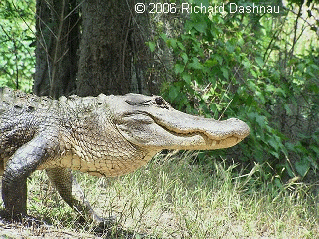
CROSSING THE TRAIL
After
it crossed, it entered the mud flats that remained at that edge of
Pilant
Lake. I knew the alligator was destined for disappointment (if
they can
feel
disappointment).
For those familiar with the park, this happened at the West end of
the
Spillway Bridge, just past the bench near the bridge.
----------------------------------------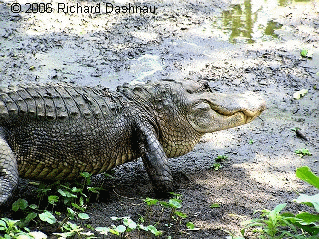 ---------
---------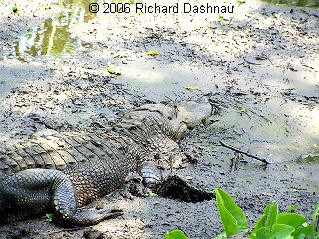
INTO
THE
MUD
WHY DID I DO THIS?
A number
of people have expressed concern over the alligators, wondering
where they
would go if the lakes dried up. This concern always gladdens me,
since
it show me they care
about the life in the park. . However, these conditions
have only lasted for a few months. Although we haven't gotten the
amount
of water we normally do for about a year, we have
been getting some
rain. The alligators have been around for MILLIONS of years. The
only thing
that came close to wiping them out was not a natural force, but
humans.
There's a
very good chance they'll do okay until our rains come back.
08/20/2006--They've
decided that 40 Acre Lake is full enough for now. The pump (see
below)
has been moved to Elm Lake. Now, in the quiet filled lake, things
are returning
to a
"normal" state. Look at the lake from the base of the Observation
Tower!
----------------------------------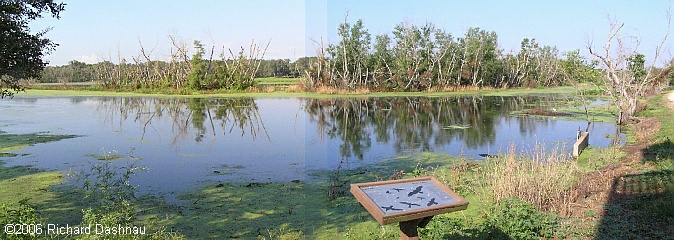 ----
----
40
ACRE LAKE 08/20/2006 FROM OBSERVATION TOWER
I arrived
at the park around 8:30am, and I was walking towards the
Observation Tower
and admiring the lake. I passed an 8 foot alligator on the bank
next to
the trail. With the water
level at a good level, the water's edge is about
6 feet from the trail. I was about 100 yards from the Observation
Tower
when I saw a large alligator crossing the trail. The first
image
below (HIGH WALKING) shows a shot when it's centered on the
trail.
The second image (STILL HIGH WALKING) shows the end of the
crossing (taken
with 17x zoom).
- -
-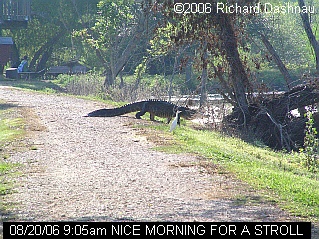 -
-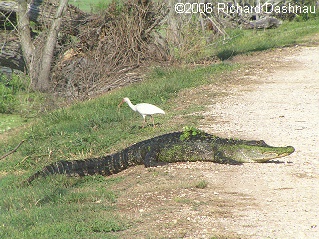
HIGH
WALKING
STILL HIGH WALKING
SUN
BATHING
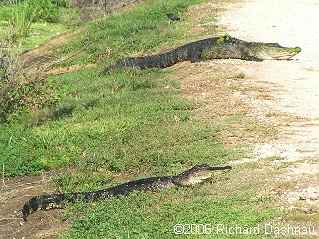

ALLIGATORS CATCHING...RAYS
IS THE COAST CLEAR?
I got
to the tower, and watched the alligators for a while. While I did,
another
alligator got up and basked (SUN BATHING, above); and not long
after, another
one joined it!
(ALLIGATORS CATCHING RAYS, above) While I waited
to see if the bigger one would cross (I love seeing the high
walk); the
smaller one walked down the trail towards me, then spread
out in the center
(IS THE COAST CLEAR?, above). Eventually, both alligators left the
trail.
I eventually
walked around the lake. In the shaded areas on the East side of
the lake,
many
alligators were near the shore. Some came up to bask, some were
hunting
at the water's edge. There's a bench near the trail turning on the
Southeast
edge of the lake. Alligators seem to
like to bask there, and I saw this
one while still some distance away. They are shy there, and
usually retreat
into the water before I can get too close. The pictures below show
the
alligator in
front of the bench, and then a cropped closeup, showing that
it is gaping. I only got a few steps closer before it entered the
water.
(and I was still at least 50 yards away)
---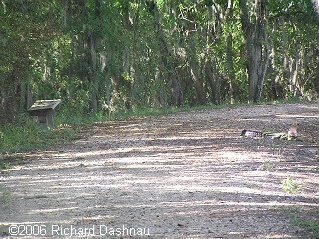 ----
----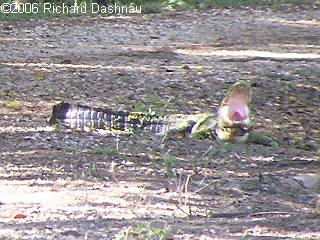
BENCHWARMER NEEDED
PINK BENCH
MARKER WITH TEETH
It's
been a while since I've seen so many alligators on land, just
basking.
I believe that the increased water depth allows the alligators to
cool
enough so that they require additional help from
the sun to warm back to
optimum metabolic temperature. The alligators I observed didn't
bask for
very long before they started gaping and/or re-entering the water.
This
also makes sense,
because the sun was very warm. The other general movement
(trail crossings) I believe are due to higher water on both sides
of the
trail, with food available on either side.
And,
here's a little bit of further news. On August 10th, we hatched
some alligator
eggs (about 28, of which 18 were "good"). I happened to be at the
park,
and so was able to help. I was
unable to get pictures because I was busy.
A week later, on August 17th, more alligator eggs were hatched (I
missed
that. I was at work.)
Then
a few more hatched on the 19th, and 1 more on the 20th.
These eggs
were taken from three nests that had been found and monitored
around 40Acre
Lake. The rising water made
taking the eggs necessary. Most of the hatchlings
will be returned to the wild---very soon. This hatching is a bit
early
(especially the August 10th) but the first batch actually began
chirping
and trying to hatch themselves. I still think any remaining
wild
nests should hatch within the next two or three weeks. I'll
probably
post some pictures of the hatchlings here later.
And,
this page shows alligators at the park, on
land, near various landmarks at the park.
Go back to my main alligator
page, Alligators
Go
back to my home page, Welcome
to rickubis.com
Go
back
to the RICKUBISCAM
page.
Go
back
to the See
the World page.















